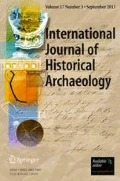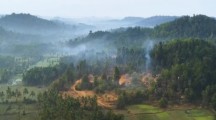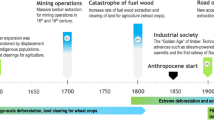Abstract
This article discusses the use of ESRI’s ArcGIS Story Map application for heritage place-making in a small, diverse, deindustrialized urban neighborhood in Binghamton, New York. “Stories from North of Main” is a Story Map that weaves together the multiple meanings residents attach to neighborhood places by layering audio, images, and text to create stories of work, home, and community life, past and present. Story Maps make visible and legible the place attachments of newcomers and long-time residents in changing city neighborhoods. These place-based stories can offer an alternative to elite-driven heritage and counter the negative narratives attached to marginalized neighborhoods.









Similar content being viewed by others
References
Alemy, A., Hudzik, S., and Matthews, C. N. (2017). Creating a user-friendly interactive interpretive resource with ESRI's ArcGIS Story Map program. Historical Archaeology 51(2): 288–297.
Allahwala, A., Bunce, S., Beagrie, L., Brail, S., Hawthorne, T., Levesque, S., von Mahs, J., and Spotton Visano, B. (2013). Building and sustaining community-university partnerships in marginalized urban areas. Journal of Geography 112(2): 43–57.
Byrne, D. (2014). Counter-mapping and migrancy on the Georges River. In Schofield, J. (ed.), Who Needs Experts? Counter-Mapping Cultural Heritage, Ashgate, England, pp. 77–92.
Byrne, D. (2008). Counter-mapping in the archaeological landscape. In Bruno, D. and Thomas, J. (eds.), Handbook of Landscape Archaeology. Left Coast Press, Walnut Creek, CA, pp. 609–616.
Chidester, R. C. and Gadsby, D. A. (2009). One neighborhood, two communities: the public archaeology of class in a gentrifying urban neighborhood. International Labor and Working-Class History 76(1): 127–146.
Conolly, J. (2008). Geographic Information Systems and landscape archaeology. In Bruno, D. and Thomas, J. (eds.), Handbook of Landscape Archaeology. Left Coast Press, Walnut Creek, CA, pp. 583–595.
Davis, D. (2011). Intergenerational digital storytelling: a sustainable community initiative with inner-city residents. Visual Communication 10(4): 527–540.
Dawdy, S. L. (2016). Profane archaeology and the existential dialectics of the city. Journal of Social Archaeology 16(1): 32–55.
De Cesari, C. and Herzfeld, M. (2015). Urban heritage and social movements. In Meskell, L. (ed.), Global Heritage: A Reader. Wiley-Blackwell, Chinchester, pp. 171–195.
De Nardi, S. (2014). Senses of place, senses of the past: making experiential maps as part of community heritage fieldwork. Journal of Community Archaeology and Heritage 1(1): 5–22.
ESRI. (2018). Frequently Asked Questions Story Maps. https://storymaps.arcgis.com/en/faq/, last modified September 30.
ESRI (2019). Story Maps Gallery. https://storymaps-classic.arcgis.com/en/gallery/, last modified (August 23).
Giaccardi, E. and Palen, L. (2008). The social production of heritage through cross-media interaction: making place for place-making. International Journal of Heritage Studies 14(3): 281–297.
Goldstein, B. E., Wessells, A. F., Lejano, R., and Butler, W. (2015). Narrating resilience: transforming urban systems through collaborative storytelling. Urban Studies 52(7): 1285–1303.
Graves, M. E. (2015). Spatial Narratives of Struggle and Activism in the Del Amo and Montrose Superfund Cleanups: A Community-Engaged Web GIS Story Map. Doctoral dissertation, University of Southern California, Los Angeles.
Guilfoyle, D. R. and Mitchell, M. B. (2015). Compliance-based archaeological heritage management and place-based participatory mapping for negotiated outcomes. Australian Archaeology 80: 80–90.
Hart, S. M. (2019). Colonialism, Community, and Heritage in Native New England. University Press of Florida, Gainesville.
Homsy, G. C. and Hart, S.M. (2019). Sustainability backfire: the unintended consequences of failing to engage neighborhood residents in policymaking. Journal of Urban Affairs, published online June 12.
Kiddey, R. and Schofield, J. (2011). Embrace the margins: adventures in archaeology and homelessness. Public Archaeology 10(1): 4–22.
Larrain, A. Á. and McCall, M. K. (2018). Participatory mapping and participatory GIS for historical and archaeological landscape studies: a critical review. Journal of Archaeological Method and Theory Published online June 25.
Litvin, S. W. and Rosene, J. T. (2017). Revisiting Main Street: balancing chain and local retail in a historic city's downtown. Journal of Travel Research 56(6): 821–831.
Low, S. (2004). The memorialization of 9/11: dominant and local discourses on the rebuilding of the World Trade Center site. American Ethnologist 31: 326–339.
Low, S. (2011). Claiming space for an engaged anthropology: spatial inequality and social exclusion. American Anthropologist 113(3): 389–407.
Markusen, A. and Gadwa, A. (2010). Arts and culture in urban or regional planning: a review and research agenda. Journal of Planning Education and Research 29(3): 379–391.
McGuire, R. H. (1991). Building power in the cultural landscape of Broome County, New York 1880-1940. In McGuire, R. amd Paynter, R. (eds.), The Archaeology of Inequality. Blackwell, Oxford, pp. 102–124.
Middleton, E. R. (2010). Seeking spatial representation: reflections on participatory ethnohistorical GIS mapping of Maidu allotment lands. Ethnohistory 57(3): 363–387.
Moore, C. R. and Thompson, V. D. (2012). Animism and Green River persistent places: a dwelling perspective of the Shell Mound Archaic. Journal of Social Archaeology 12(2): 264–284.
Novak, S. (2017). Corporeal congregations and asynchronous lives: unpacking the pews at Spring Street. American Anthropologist 119(2): 236–252.
O’Donovan, M. (2014). A tale of one city: creative destruction, spatial fixes and ideology in Binghamton, New York. International Journal of Historical Archaeology 18: 284–298.
Rattray, N. A. (2015). Counter-mapping as situated knowledge: integrating lay expertise in participatory geographic research. In Gubrium, A., Harper, K. and Otanez, M. (eds.), Participatory Visual and Digital Research in Action. Left Coast Press, Walnut Creek, CA, pp. 131–146.
Refsland, S. T., Tuters, M., and Cooley, J. (2007). Geo-storytelling: a living archive of spatial culture. In Cameron, F. and Kenderdine, S. (eds.), Theorizing Digital Cultural Heritage: A Critical Discourse. MIT Press, Cambridge, MA, pp. 409–416.
Schlanger, S. H. (1992). Recognizing persistent places in Anasazi settlement systems. In Rossignol, J. and Wandsnider, L. (eds.), Space, Time and Archaeological Landscapes. Springer, New York, pp. 91–112.
Sletto, B. I. (2009). “We drew what we imagined”: participatory mapping, performance, and the arts of landscape making. Current Anthropology 50(4): 443–466.
Smith, L. (2006). Uses of Heritage. Routledge, London.
Turner, M. and Tomer, T. (2013). Community participation and the tangible and intangible values of urban heritage. Heritage and Society 6(2): 185–198.
UNESCO (2012). The Records of the 36th session of the General Conference – 36th Session. October / November 2011. France, Paris, https://unesdoc.unesco.org/ark:/48223/pf0000215084.page=52.
UNESCO (2011). UNESCO Recommendation on the Historic Urban Landscape. last modified (November 10) accessed September 2018, https://whc.unesco.org/en/hul/.
UNESCO/World Heritage Center. (2013). New Life for Historic Cities: The Historic Urban Landscape Approach Explained. https://whc.unesco.org/en/activities/727/.
Acknowledgments
This project was funded, in part, by a Binghamton University Sustainable Communities Transdisciplinary Area of Excellence grant and Binghamton University’s Center for Civic Engagement. We thank research assistant Kate Dillon as well as the Anthropology and Sustainable Communities students who conducted and coded interviews and researched and created Story Map content. Thank you to Dr. Pamela Mischen for introducing us to the neighborhood and for Safe Streets for embracing us as partners in this effort. We appreciate the reviewers and editors of this issue who provided thoughtful feedback and guidance, and Maria O’Donovan for sharing expertise on Binghamton’s history. Most importantly, we wish to thank the residents of the North of Main neighborhood who generously shared their stories, knowledge, and experiences with us.
Author information
Authors and Affiliations
Corresponding author
Additional information
Publisher’s Note
Springer Nature remains neutral with regard to jurisdictional claims in published maps and institutional affiliations.
Rights and permissions
About this article
Cite this article
Hart, S.M., Homsy, G.C. Stories from North of Main: Neighborhood Heritage Story Mapping. Int J Histor Archaeol 24, 950–968 (2020). https://doi.org/10.1007/s10761-019-00529-4
Published:
Issue Date:
DOI: https://doi.org/10.1007/s10761-019-00529-4




